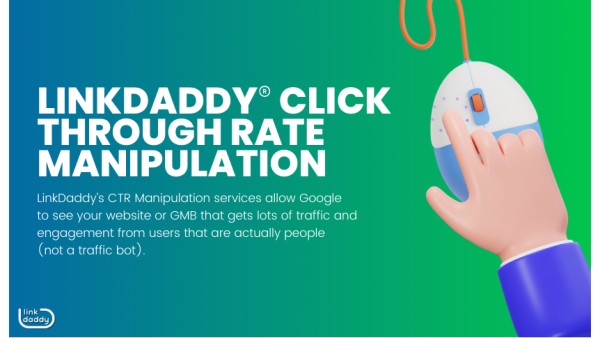Attain Much Better Outcomes With Smart CTR Control Methods
In the competitive landscape of electronic advertising, achieving premium outcomes through clever CTR control strategies is crucial for driving interaction and conversions. By focusing on components such as compelling headlines and critical visuals, marketing professionals can substantially enhance their click-through prices.
Understanding Click-Through Fees
Click-through prices (CTR) serve as an essential statistics in digital advertising and marketing, mirroring the efficiency of online web content in interesting individuals. CTR is defined as the proportion of individuals who click a specific web link to the total variety of users that see the content, revealed as a percentage. A higher CTR shows that the content reverberates with the target market, triggering them to act, while a lower CTR might suggest the demand for improvement in messaging or presentation.
Several factors influence CTR, including the top quality of the material, the relevance of keyword phrases, and the beauty of calls-to-action (CTAs) Well-crafted headlines can substantially improve user interest, driving more clicks. Furthermore, aesthetic aspects such as photos and video clips can boost involvement, making the content more appealing.
Comprehending CTR is important for enhancing digital advertising and marketing approaches. Marketing professionals can examine CTR information to recognize fads and make educated choices pertaining to material adjustments, targeting strategies, and general campaign efficiency. By constantly keeping an eye on and fine-tuning these aspects, services can function towards accomplishing far better involvement and ultimately, higher conversion prices.
Relevance of Targeted Messaging
Reliable interaction in electronic advertising and marketing requires more than just engaging visuals and engaging material; it requires a deep understanding of the target audience. CTR Manipulation. Targeted messaging is essential because it permits marketers to customize their communications to particular segments, making certain that the messaging reverberates with the needs, choices, and discomfort points of possible clients
When messages are aligned with the target market's rate of interests, the possibility of engagement increases significantly. This strategy not only enhances click-through prices (CTR) but additionally cultivates a deeper link in between the brand and its audience. By making use of information analytics, marketing professionals can determine group variables such as age, place, and getting habits, enabling them to craft tailored messages that talk directly to individual consumers.
A/B Testing for Optimization
Optimization is a critical news component of successful digital marketing techniques, and A/B testing acts as a powerful tool in this process. This approach enables marketing experts to contrast 2 or even more variants of a campaign element, such as headlines, images, or call-to-action buttons, to determine which version yields the highest click-through rate (CTR)
By randomly segmenting your audience and subjecting each group to a different version of the marketing material, A/B testing offers empirical data pertaining to customer preferences and behavior. The insights acquired from these tests enable marketing professionals to make data-driven choices, guaranteeing that sources are alloted properly for optimal influence.
To execute A/B testing effectively, it is crucial to define clear objectives and establish essential performance indications (KPIs) for measurement. Running examinations over an enough duration and guaranteeing statistically considerable sample dimensions are important to drawing legitimate verdicts.
Eventually, A/B testing not only enhances the performance of specific advertising components yet additionally contributes to a more comprehensive understanding of customer habits. By constantly fine-tuning strategies based upon examination results, online marketers can accomplish sustained renovations in CTR and general campaign efficiency, causing greater return on financial why not find out more investment.

Using Behavioral Insights
By leveraging behavior understandings, marketers can get a much deeper understanding of consumer inspirations and preferences, enabling them to craft even more targeted and engaging campaigns. Behavioral understandings encompass different information points, including previous acquisition behavior, web site interactions, and interaction patterns. Analyzing these elements permits marketers to determine fads that inform content development and network option.
For instance, comprehending optimal involvement times can aid online marketers routine campaigns when customers are most responsive. By segmenting target markets based upon their behavior patterns, customized messages can reverberate a lot more effectively, enhancing click-through rates (CTR) Recognizing the emotional triggers that lead to conversions can guide the development of persuasive copy and visuals.
Inevitably, utilizing these insights not just boosts CTR yet additionally fosters more powerful customer partnerships, leading to higher retention prices. In an affordable landscape, the calculated application of behavioral understandings is essential for driving purposeful interaction and attaining sustainable marketing success.
Surveillance and Changing Approaches
Constant monitoring and adjustment of marketing methods are important for maximizing click-through prices (CTR) and guaranteeing project performance. To achieve this, online marketers should develop key efficiency indicators (KPIs) that line up with their objectives, enabling real-time analysis of project efficiency. This data-driven approach enables groups to identify patterns and fads that are necessary in understanding target market behavior.
Frequently reviewing ad performance, including impressions, clicks, and engagement metrics, helps with timely adjustments. If a specific advertisement set underperforms, it may require adjustments in copy, visuals, look here or targeting criteria. A/B testing is an efficient technique to compare different versions of ads and determine which aspects resonate more with the target market.

Conclusion
In final thought, effective click-through price (CTR) control approaches necessitate a comprehensive understanding of audience actions and choices. Prioritizing targeted messaging, engaging web content, and A/B testing can substantially enhance campaign efficiency. The assimilation of behavioral insights even more fine-tunes these initiatives, leading to even more powerful interaction. Continuous monitoring and modification of methods make sure responsiveness to adjustments in engagement metrics, ultimately optimizing conversion prices and driving effective advertising and marketing outcomes.